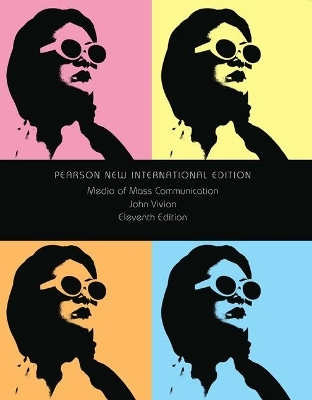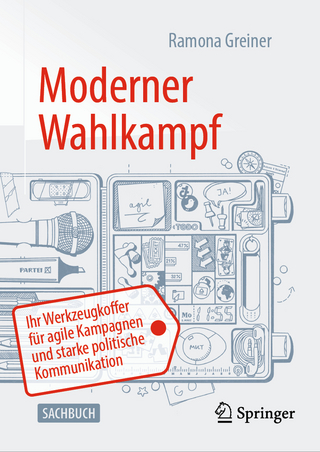
Media of Mass Communication
Pearson Education Limited (Verlag)
978-1-292-02523-0 (ISBN)
The material engages students as both consumers and creators of mass media. Students explore the latest media economic, technological, cultural and political shifts all in historical context. They engage with the coverage of ongoing transformations in mass media as analysts, examining the various ways in which media impacts the world as they hone their media literacy skills. Praised for its dynamic writing style, The Media of Mass Communication, 11e helps students see why the media are in such a tumultuous transition and provides tools for understanding the reshaping of the entire media industry.
Personalize Learning–MyCommunicationLab for Mass Communication delivers proven results in helping students succeed, provides engaging experiences that personalize learning, and comes from a trusted partner with educational expertise and a deep commitment to helping students and instructors achieve their goals. With tools such as MediaShare (our video upload and commenting tool), MyOutline, and self-assessments in MyPersonalityProfile, MyCommunicationLab works with students and instructors to personalize the learning experience and make it more effective.
Improve Skill Development and Application– Pedagogical tools including Study Preview; Chapter Wrap-Up, Review Questions; lists of key concepts, terms and people; and Media Sources help students understand central concepts and prepare for the course. Additional activities on MyCommunicationLab.com emphasize skill-building and applications.
Engage Students– Introductory vignettes at the beginning of each chapter provide evocative stories that illustrate important issues about the mass media and provide colorful descriptions about people who contributed significantly to the mass media. “Media People” boxes profile key figures in media industries. New “Media Counterpoints” boxes explore two sides of an issue, presenting the key arguments on controversial topics and providing critical thinking questions designed to help students determine their own positions on each issue.
Explore Examples of contemporary communication– New “Media Tomorrow” boxesaddress the impact of new technologies on media as well as the public’s changing media consumption patterns. Topics range from eyetracking tablet users’ media access to the growth of digital publications and governmental online access policies.
Emphasize Learning Outcomes–“Media Timelines” cast key development in the mass media in a graphic chronology and place media milestones in the larger social context. To help students establish a greater framework for understanding how issues such as culture, democracy, economy, and audience fragmentation in the media, interact with each media industry differently and relate to media literacy, each chapter concludes with a highly visual “Thematic Summary.”
Understand Theory and Research — Students also can access Pearson’s MySearchLab where they can get extensive help on the research process as well as access four databases of credible and reliable source material (for details, please see www.mysearchlab.com ). MySearchLab also contains an AutoCite feature that assists students in the creation of a Works Cited document (using APA, MLA, or Chi
CHAPTER ONE: MASS MEDIA LITERACY
Media Ubiquity
Mediated Communication
Literacy for Media Consumers
Assessing Media Messages
Purposeful Mass Communication
Media and Society
CHAPTER TWO: MEDIA TECHNOLOGY
Media Technology
Printing Technology
Chemistry Technology
Electrical Technology
Current Technologies
Digital Integration
Technology and Mass Communication
CHAPTER THREE: MEDIA ECONOMICS
Financial Foundations
Ownership Structures
Alternative Media Ownership
Government Role
New Media Funding
Media Economic Patterns
CHAPTER FOUR: INK ON PAPER
Print Media Industries
Newspaper Industry
Leading Newspapers
Magazine Industry
Reinventing Magazines
Book Industry
Book Genres
Book Industry Prospects
Post-Print Culture
CHAPTER FIVE: SOUND MEDIA
Long-Term Symbiosis
Recording Industry
Radio Industry
Characteristic of U.S. Radio
Influence of Radio
Radio Industry Directions
CHAPTER SIX: MOTION MEDIA
Movie-Television Meld
Movie Industry
Television Industry Structure
Movie Industry Structure
Motion Media Products
Platform Flux
CHAPTER SEVEN: NEW MEDIA LANDSCAPE
Jobs’ Historical Model
Portals
Search Engines
Messaging
User-Generated Sites
Online Commerce
Online Domination
Games
Archives
CHAPTER EIGHT: NEWS
Concept of News
Bennett News Model
Hutchins News Model
Rethinking News Models
Personal Values in News
Variables Affecting News
Quality of News
Journalism Trends
CHAPTER NINE: ENTERTAINMENT
Entertainment in History
Mediated Performance
Storytelling
Music
Sports as Media Entertainment
Sex as Media Content
Gaming as Media Content
Artistic Values
CHAPTER TEN: PUBLIC RELATIONS
Public Relations Scope
Public Relations in Context
Roots of Public Relations
Public Relations as Strategy
Public Relations Tactics
Professionalization
CHAPTER ELEVEN: ADVERTISING
Importance of Advertising
Origins of Advertising
Advertising Agencies
Placing Advertisements
Brand Strategies
Advertising Tactics
Contemporary Advertising Techniques
CHAPTER TWELVE: MASS AUDIENCES
Discovering Mass Audiences
Audience Measurement Principles
Measuring Audience Size
Audience Measurement Techniques
Measuring Audience Reaction
Audience Analysis
CHAPTER THIRTEEN: MASS MEDIA EFFECTS
Effects Theories
Lifestyle Effects
Attitude Effects
Cultural Effects
Behavioral Effects
Media-Depicted Violence
CHAPTER FOURTEEN: MASS MEDIA GLOBALIZATION
Mass Media and the Nation States
War as a Libertarian Test
Online Global Reform
Trans-Border Soft Diplomacy
Arab Media Systems
China Model
CHAPTER FIFTEEN: ETHICS
The Difficulty of Ethics
Media Ethics
Moral Principles
Process versus Outcome
Potter’s Box
Ethics, Law and Practicality
Unsettling Media Issues
| Verlagsort | Harlow |
|---|---|
| Sprache | englisch |
| Maße | 218 x 281 mm |
| Gewicht | 1008 g |
| Themenwelt | Sozialwissenschaften ► Kommunikation / Medien ► Kommunikationswissenschaft |
| Sozialwissenschaften ► Kommunikation / Medien ► Medienwissenschaft | |
| ISBN-10 | 1-292-02523-9 / 1292025239 |
| ISBN-13 | 978-1-292-02523-0 / 9781292025230 |
| Zustand | Neuware |
| Haben Sie eine Frage zum Produkt? |
aus dem Bereich


